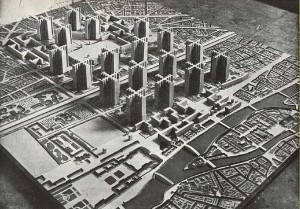
The above image, was published in the Newcastle Herald on the 1st of June 1968. This proposed plan for Newcastle East involved the complete leveling of the city centre and was credited to an unidentified “professional man in the City.” The plan called for the existing urban environment to be replaced with a utopian dreamscape of high density housing, parks, carparking and a shopping mall that would “allow housewives to shop at their leisure in quiet surroundings.”

This scorched earth approach to urban planning was pioneered by the architect Le Corbusier who in 1925 put forward his Plan Voisin for Paris. This called for the destruction of large sections of central Paris, replacing the antiquated and disparate architecture with a unified new order of high density housing, parks etc. In Le Corbusier defence there was an element of avant-garde provocation in his proposal. However, this didn’t stop his vision for a new urbanism becoming the default setting for much twentieth century town planning.
While this vision for Newcastle thankfully never came to pass, there is one element to the plan that is today as topical as it is contentious, the abolition of the railway line into Newcastle central . In recent years this issue has become a planning impasse with the current GPT backed redevelopment of the CBD stalled as the State Government undertakes a transport study for the area. The results of the study are due in June 2010. A virtual tour of the new future Newcastle is viewable here.






















